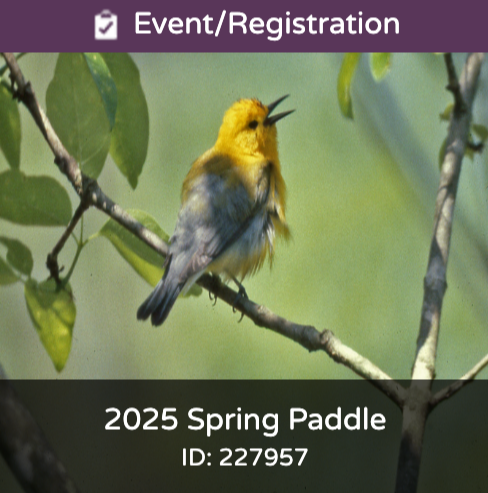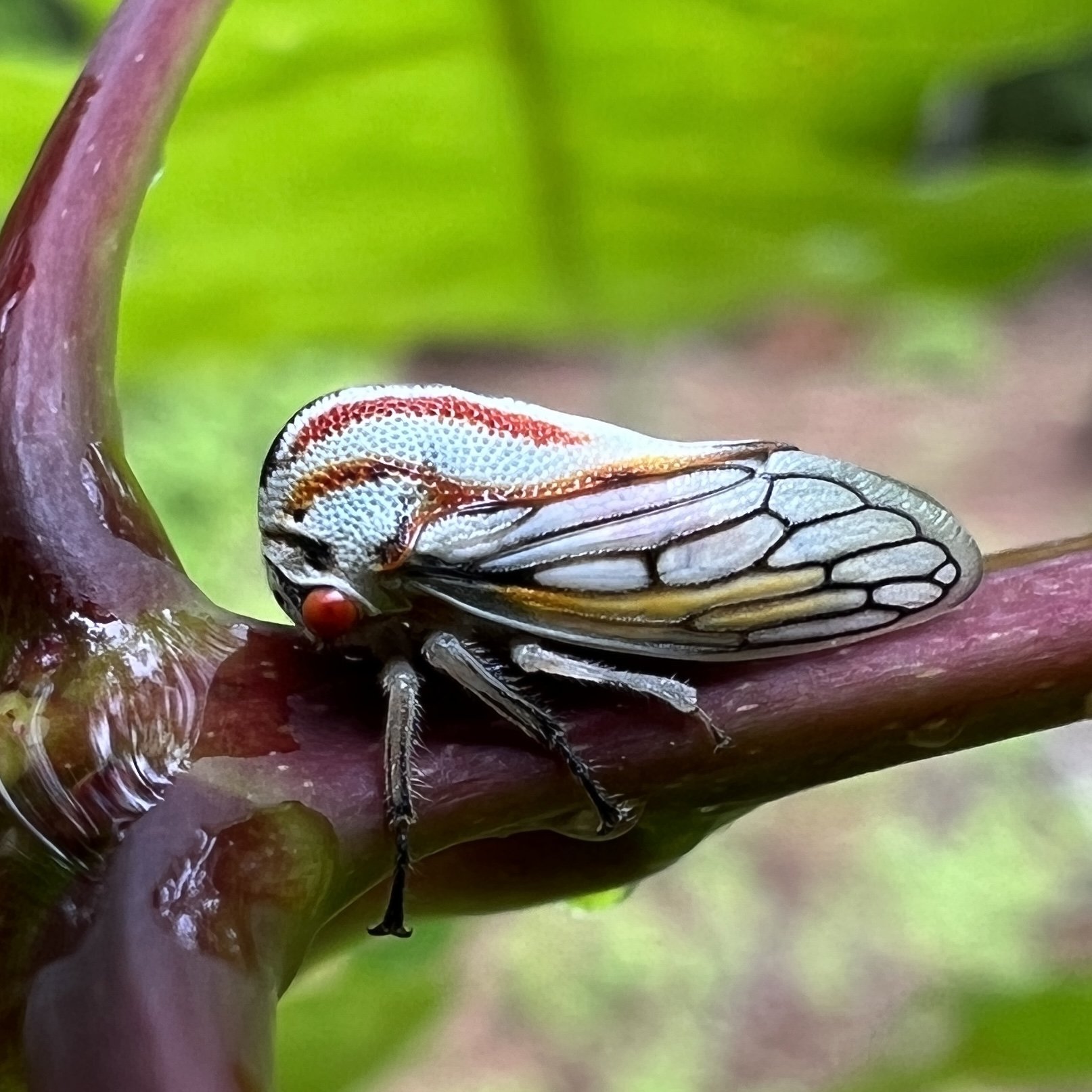On March 12th, Judy Thomas gave our first pop-up presentation on galls. The presentation was recorded, and if you could not attend, you can access the recording through the link below for the next 90 days. I have also included her slide presentation so you can access the resources and links she shared. I encourage you to explore the world of galls more deeply with Judy's fantastic work. This pop-up counts as continuing education, and you are encouraged to log your time into Better Impact.
Sign-ups for FODR’s Spring Paddle Trips
Register on our website Dragonrun.org beginning at 9:00 am March 8th. If you are signing up for more than one person, please prepare ahead. We will need the full name, cell phone number, and email address of each individual participant. (must be 18 years and older ) A donation of $60 is requested at the time of signup using a credit card.
Our Spring Paddle season runs from April 18th to May 22nd.
Bird Flu in South America
NN Box Turtle Identification Project
Master Naturalists who are interested in this project need to attend the ZOOM Training Workshop, 7:00 p.m. Monday, April 15th.
Please RSVP to Bob Dunstan to receive ZOOM link: robertwdunstan@yahoo.com
Private Osprey Nest Platforms Needed for CCB research project
The Cranefly Orchid
I highly enjoy winter hikes. The underbrush is often bare of leaves, enabling one to have better visibility of the forest floor and the small plants that survive the cold and grow there. One of the plants that I find highly visible in the winter is Tipularia discolor or Cranefly Orchids. Cranefly Orchids were one of the first orchids I learned to identify using just the leaves. The purple underside of the leaves was a hidden surprise that sparked my curiosity and fueled my desire to learn more about the story of this abundant orchid. Unfortunately, my search for ethnobotanical resources on the Cranefly Orchid yielded very little. However, learning about the relationships this orchid shares with its environment was equally as fascinating.
DOF Acorn Collecting Project
Binocular Recommendations from a few trusted sources
If You Enjoy the Outdoors, Become a Northern Neck Master Naturalist!
Surprise Encounter at Chilton Woods
I love to look closely at small things in the natural world. On April 28, I was looking closely at a branch of a White Oak tree at Chilton Woods. When I went to grab a nearby branch, I was startled to realize that the branch was lined with small black and white striped insects. On even closer inspection I was transfixed by their bizarre coloration and appearance. I took lots of photos, of course, and when I got home I found out that they were Oak Treehoppers (Platycotis vittata) in their nymph stage. So once a week I made a point to visit this same tree and I was thrilled that they were there each time. My happy surprise came on May 16, when I was treated not only to the sight of an adult, but I also saw a newly emerging adult shedding its nymph skin. I’m so happy that I took a closer look in the first place and even more happy that I kept coming back to look again and again. — Anne Parker, BTC19
Climate change takes hold in NC ghost forests
Surprise Encounter — Bluebirds
Audubon Winter Waterfowl Count 2022
Washington's Birthplace Christmas Bird Count update
Redhead, American Widgeon ducks. photo by Jeff Wright
From Bill Portlock, WBCBC Compiler
Dear Washington’s Birthplace Christmas Count participants,
Thank you for participating in the 2021 annual George Washington’s Birthplace Christmas Bird Count. This was our 29th consecutive year. The National Audubon Society counts this as year 122 since it is the 122nd year of the national count.
Our December 19, 2021 count was notable for the continuing Covid-19 pandemic, social distancing and no compilation dinner again, among other things. Despite this, our participant numbers (24) and efforts in the field (miles and hours, on foot and in vehicles and by wheelchair) were higher than in previous years. Thank you. With a few exceptions, birds seemed harder to find in any large numbers due to morning rain/wind. Our total of 97 species was lower than many of our previous years’ counts where we exceeded 100 species.
While the 15,000+ canada geese reported this year is a large number, it was c. 8,000 fewer than last year’s total of 24081. Eighteen waterfowl species were reported but all 3 species of scoters, long-tailed duck, and both usual loon (waterbird) species were missed due to the high winds creating 2-3-foot breaking waves on the Potomac River.
Many species’ numbers hovered on the low count side. Only 16 great blue herons were reported from all parties combined, and were the only waders making the count tally. While a respectable eleven raptor species were reported (buteos, accipiters, eagles, falcons and owls), bald eagle (119) was the only species in the raptor group in double digits.
An all-time high of 30 laughing gulls were at Leedstown wile a single bonaparte’s gull was found across the Rappahannock River in Essex Co. Pileated woodpeckers were a high count species with 36 reported. Sadly, bobwhite were not found this year. Brown creeper (13), house wren (2), and winter wren (12) comprised high count species while 32 fox sparrows, 75 rusty blackbirds, and a remarkable 14 palm warblers completed the species noted in the high count category.
I wish you a happy and safe 2022. Good birding!
Species Count Summary
cw = Reported count week
US = Flagged as an unusual species
HC = Flagged as an unusually high count
LC = Flagged as an unusually low count
Congratulations NNMN Basic Training Class of 2021!
This hearty group of 18 began weekly on-line course work toward becoming a Certified Virginia Master Naturalist in early August of 2021. Field work to various locations around the Northern Neck and Middle Peninsula took place on a number of fall Saturdays. Great outings OUTSIDE to explore, connect and learn. A celebration to mark the end of course work was held on Sunday, December 12, 2021. Next task is to complete 40 hours of volunteer service in support of area natural resources and attain the status of Certified Virginia Master Naturalists! Check out Camille’s BTC Top Ten for a giggle.
Why We Plant "True Species" Native Plants, Not Cultivars
Native cultivars, sometimes called “nativars,” are patented plants. Once the plant breeder is satisfied—with the double flower, the altered color, or whatever characteristic is being cultivated for—the plant is named, patented and marketed, then genetically identical plants are mass produced for sale. These plants will have a brand name in single quotation marks after the genus and species names, e.g. Echinacea purpurea ‘Double Decker’ (pictured, with its freakish second set of ray flowers sticking out of the cones).
…
So, what’s the problem with all these cultivars? Read the full article here:
Cultivar: Echinacea purpurea “Double Decker”
Ghost Forests Could Provide Respite for Marsh Birds as Coastal Habitat Disappears
Scientists want to ensure that swaths of trees killed by saltwater flooding are more than dead forest, but become quality marsh habitat for birds.
By Carlyn Kranking, Editorial Fellow, Audubon Magazine
January 05, 2022
Ghost forest along Watch House Trail at Belle Isle State Park. photo by Marty Hill
At Blackwater National Wildlife Refuge in Maryland, acres upon acres of dead tree trunks stand sentinel, their bases partially covered by salt water. Back in 2003, Hurricane Isabel struck the refuge before it could recover from an unusually dry summer. The storm surges brought salty ocean water into the already parched landscape and essentially choked the salt-intolerant trees to death.
A 280-mile drive away, at Alligator River National Wildlife Refuge in North Carolina, it’s a similar story. Full story here.
It's Time to Redefine 'Birding'
Anyone who enjoys birds—wherever, however—should be able to call themselves a birder.
By Freya McGregor, Contributor, Audubon Magazine , August 02, 2021
Redefining birding. photo by Lia Bocchiara, Audubon.
Language matters. As birders, the words we use signal what we value. To nurture a community as wonderfully diverse as the birds we love, we need to ensure our language is as welcoming and inclusive as possible. One easy way to do this is to redefine “birding” and who a “birder” is.
Freya McGregor (she/her), OTR/L, CIG is the Birdability Coordinator and Occupational Therapist. You can follow her on Instagram @the.ot.birderand learn more about Birdability at birdability.org You can also hear her on Talkin’ Birds, where she works part time as the Outreach Coordinator and shares some of her birding adventures with listeners via audio postcards.
Ever wonder?
Deformity allowed encircling;
Encircling allowed deformity.
A kiss became locked lips,
a touch, shared skin:
a sylvan mystery.
The coupling doubles,
tugging bark but xylem
and phloem too.
With bypasses grafted
shared nutrients flow.
Without one root
or one trunk shaft
both trees survive.
No barrier separates
this symbiotic twist;
Asymmetries do persist.
~ Dr. James Dunstan 11/25/2018
(Dr. Dunstan is the brother of BTC 2021 trainees Betsy Maddux and Bob Dunstan)
photo by J. Dunstan
The American Bumble Bee Takes an Important Step Toward Federal Protection
American Bumblebee, Bombus pensylvanicus. photo courtesy of Judy Gallagher
PORTLAND, Ore.; Wednesday, September 29, 2021---Responding to a petition to list the American bumble bee (Bombus pensylvanicus) as an endangered species, the US Fish and Wildlife Service (FWS) issued a positive 90-day finding, indicating that the bumble bee may warrant federal protection under the Endangered Species Act (ESA). The 90-day finding initiates a formal review by the FWS, including a Species Status Assessment (SSA). The Center for Biological Diversity and the Bombus Pollinator Association of Law Students of Albany Law School submitted the petition earlier this year.
The American bumble bee, as its name implies, was once broadly distributed across much of the U.S. and has one of the widest ranges of all North American bumble bees, from southern California and the Desert West (including parts of Mexico) through the Great Plains and out to the east coast, from Florida to Canada. However, many studies suggest that the American bumble bee is declining, especially in the northern part of its range. It is listed as Vulnerable on the IUCN Red List.
The rest of the article can be found here:
https://xerces.org/press/american-bumble-bee-takes-important-step-toward-federal-protection
Check this out to read more on Bumblebee Conservation:
https://xerces.org/bumblebees
Bumble bees are beneficial and effective pollinators, helping to pollinate not only beautiful wildflowers, but also crops and gardens that provide us with nutritious fruits and vegetables. Sadly, these friendly insects are in decline due to a multitude of issues, including but not limited to, habitat loss, pesticide use, pollution, and mites. The easiest way to help bumble bees is to plant native habitat. — U.S. Forest Service
ABOUT THE XERCES SOCIETY FOR INVERTEBRATE CONSERVATION
The Xerces Society for Invertebrate Conservation protects the natural world by conserving invertebrates and their habitat. Established in 1971, the Society is a trusted source for science-based information and advice and plays a leading role in protecting pollinators and many other invertebrates. Our team draws together experts from the fields of habitat restoration, entomology, plant ecology, education, community engagement, pesticides, farming and conservation biology with a single passion: Protecting the life that sustains us. To learn more, visit xerces.org or follow us @xercessociety on Twitter, Facebook or Instagram.









